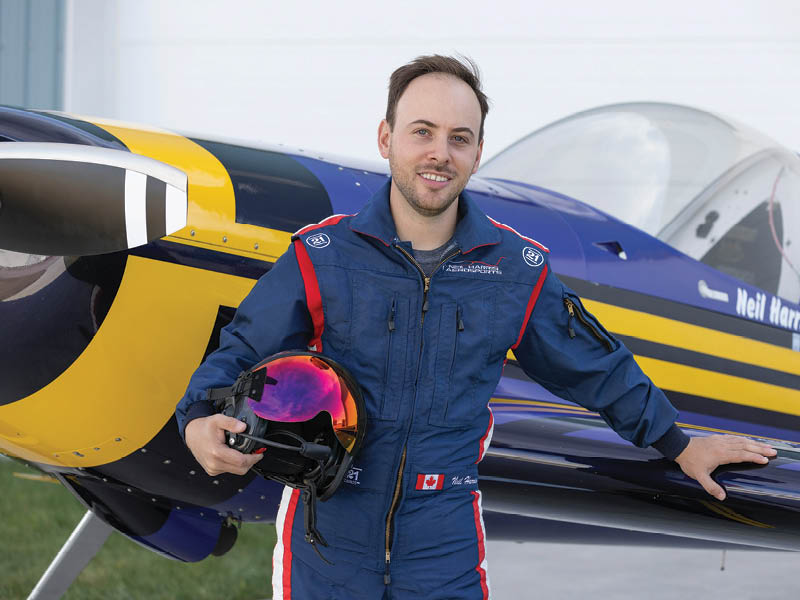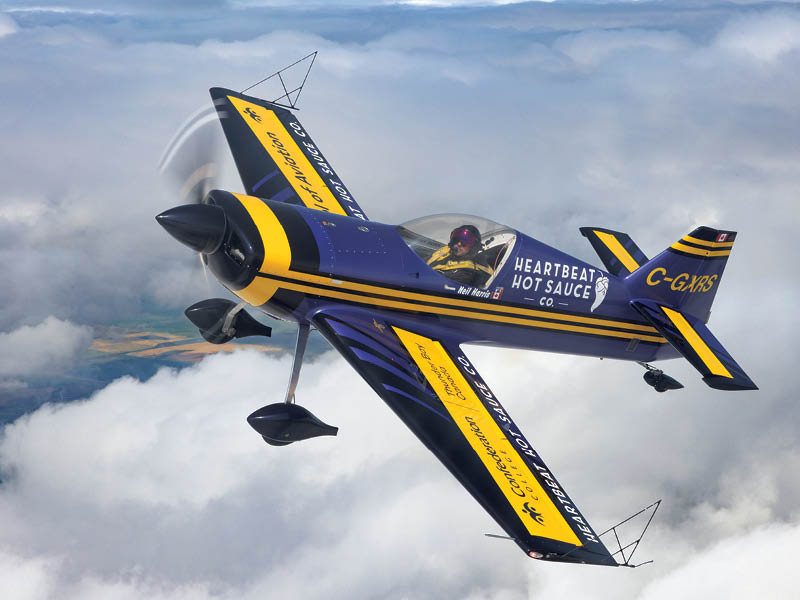WestJet Pilot Showcases His Award-Winning Aerobatics Skills
By John Perkinson, Senior Staff Writer

F/O Neil Harris (WestJet), Canada’s top-ranked competition pilot, in front of his four-cylinder engine, 240-horsepower Giles G-200.
Precision flying is a passion for F/O Neil Harris (WestJet), who earned the title Canadian Advanced National Champion last year for a second time while performing as a competition aerobatics pilot. Flying his blue Giles G-200, Harris won each of the regional contests he competed in and participated last fall as a member of the Canadian Aerobatic Team in the 15th FAI World Advanced Aerobatic Championship in Las Vegas, Nev. He finished the year as the top-ranked Canadian competition pilot.
“Competition aerobatics differs from air show flying in that every pilot must fly the same designated sequence of maneuvers, which are graded by a panel of judges,” the suburban Calgary, Alb., resident remarked. “Performances are evaluated on the precision of the lines and angles flown, the symmetry of the maneuvers, and the roundness of the full and partial loops. The performance is also rated based on an assigned difficulty coefficient for each maneuver and how well the flying is positioned within a predetermined aerobatic box.” As a result, there’s a very slim margin for error.
The Giles G-200 Harris flies is constructed of a carbon-fiber composite and features a cantilever low wing, a four-cylinder engine with 240 horsepower, and a single-seat enclosed cockpit. “The plane was specifically built for competition flying. Everything about it is designed to present well in front of a judge,” he observed. Of the G-200, Harris added, “They don’t make them anymore. There are only a handful still around.”
Prior to his current aircraft, Harris owned a Zenith CH180 Super Acro, which he flew in 2016 for his first competition—the Flagstaff Flyers Regional Contest at Killam-Sedgewick/Flagstaff Regional Airport near Killam, Alb. “I now assist in putting on that event as contest director and help arrange everything,” he said.

Harris performs maneuvers in his Giles G-200, which was specifically built for competition flying.
From the beginning, Harris seemed destined to become a pilot. “Both my father and uncle were pilots so I grew up around aviation. It’s what I always wanted to do,” he noted.
In 2009, his family relocated from Canada to the UK where his father temporarily flew for a British-based carrier. By chance, Harris attended the 25th World Aerobatic Championship in nearby Silverstone. “Watching that contest sparked my interest,” he recalled. “From that point on, I started thinking about how I could compete in these events.”
Like his father, Harris graduated from the Aviation Flight Management program at Confederation College in Thunder Bay, Ont., before going to work for Wasaya Airways. He was hired in 2012 to work on the ramp, loading and fueling aircraft at Pickle Lake Airport in Pickle Lake, Ont., but soon transitioned to the flight decks of the Pilatus PC-12, the Cessna Caravan, and the de Havilland Dash 8.
In 2014, Harris began flying for WestJet Encore and, three years later, moved to WestJet, where he’s currently a B-787 pilot.
Harris remarked that he doesn’t compete during the winter months. But in the summer, as part of his training regimen, he tries to fly every day if the weather’s good and he’s not scheduled for airline work. Harris typically participates in one contest a month for a total of three or four events a year.
In preparation for this year, he observed, “On my test flight out of annual inspection, I went vertical and noticed fuel pouring off my left wing. The fuel was leaking from the wing tank into the wing behind the tank and then dumping out of the vent holes in the trailing edge of the wing. Although the leak was hard to pinpoint, I think I got it.”
This season, the WestJet pilot is slated to fly the Flagstaff Flyers Regional Contest in July; the Central Canada Aerobatic Championships near Winnipeg, Man., in August; and the Rocky Mountain House Contest in Rocky Mountain House, Alb., in late August.
Harris acknowledged that he’s accomplished many of the competition goals he originally set for himself. Moving forward, he’d like to transition to air show flying but admits he can’t resist the urge to compete. However, given the enormous amount of time required to prepare for the two types of events, Harris conceded, “I want to do a bit of both, but not a whole lot of either.”

